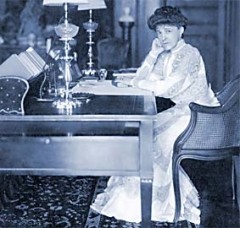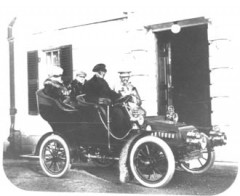The Mount
Introduction
Text-to-speech Audio
Images
Edith Wharton at The Mount, 1905

Edith Wharton motoring with Henry James and Teddy Wharton at The Mount, 1904.

The Mount, Edith Wharton's estate in Lenox, Massachusetts

Backstory and Context
Text-to-speech Audio
Edith Wharton was born January 24th, 1862 to a distinguished New York family. This time was known as "Old New York", meaning women were discouraged from achieving anything beyond proper marriage. It is also called the Gilded Age, meaning post-Civil War period of American expansion in business and arts. It was a tightly controlled society; one that Wharton broke through to become one of America's greatest writers. Her life stands as an example of the obstacles that a women in her time had to overcome to find self-realization; just like the characters in the books she wrote.
Edith's parents were descendants of English and Dutch colonists who had made fortunes in shipping, banking, and real estate. Edith moved to Manhattan when she was ten. She did not attend school, but educated herself by reading from her father's library. In 1885, when she was 23, she married Edward Robbins Wharton. He came from similar social background, but they did not share similar interests which led to an unhappy marriage.
Edith Wharton's writing career was launched in 1897 with the publication of her first book, The Decoration of Houses, which she was a co-author with her architect friend Ogden Codman. The two authors denounced Victorian decorating practices, and proposed creating rooms based on simple, classical design principles such as symmetry, proportion, and balance. Her book states that "lambrequins, jardinières of artificial plants, wobbly velvet-covered tables littered with gewgaws, and festoons of lace on mantelpieces and dressing tables" were a thing of the past. Decoration of Houses was an immediate success. The Mount was Wharton's design where she implemented those principles in 1902. Soon after this book was written, Wharton suffered a nervous breakdown and her physician suggested she write fiction instead.
In 1899, her collection of short stories The Greater Inclination appeared. In her 1905 novel The House of Mirth, Wharton depicted the contemporary world of the rich and the materialism. In 1921, she won the Pulitzer Prize for her Age of Innocence, written in 1920. In 1934 she wrote an autobiography A Backward Glance. She died on August 11, 1937.
